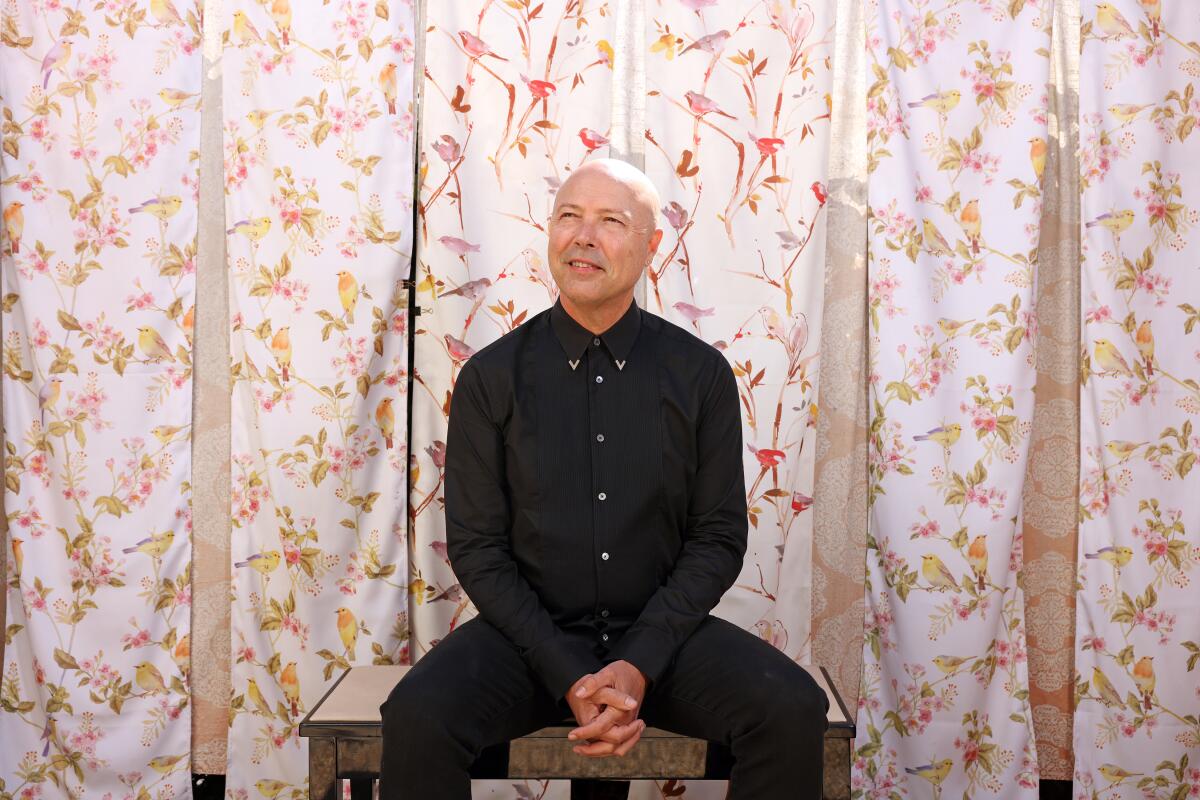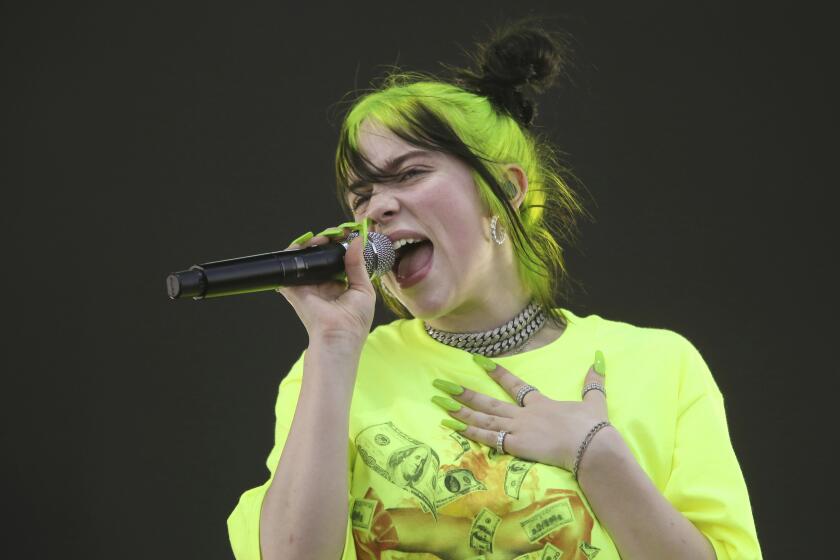On Sunday, a local jazz polymath could have a Grammys for the ages

- Share via
Whether you know it or not, you’ve heard John Beasley play. He’s a shape-shifting pianist, arranger, composer and session musician, and his mark can be found on a mix-and-match volume of projects known by millions.
Beasley’s deft work punctuates TV series and movies including “Wall-E,” “Family Ties,” “Finding Nemo,” “Cheers,” “Austin Powers,” “Skyfall,” “American Idol” and “Erin Brockovich.”
In the studio and onstage, Beasley’s played with Miles Davis, Barbra Streisand, Destiny’s Child, Diane Reeves, James Brown, Steely Dan, Queen Latifah, Baaba Maal, Chaka Khan and hundreds of others.
Despite the heady list of credits, Beasley, 60, is still relatively unknown, but you may hear his name Sunday in that most mainstream of musical settings: He is nominated for four Grammy Awards, tied for fourth-most this year alongside pop stars Billie Eilish, Justin Bieber, Phoebe Bridgers and DaBaby, among others.
“People know who those people are,” Beasley says with a laugh during a recent conversation.
The Recording Academy announced Sunday that Harry Styles, Bad Bunny, Post Malone, Megan Thee Stallion and Dua Lipa would also hit the stage March 14.
Beasley is nominated for two Grammys for his arranging work: In the category of arrangement, instrumental and vocals, he’s nominated for the track “Asas Fechadas,” from Maria Mendes’ album “Close to Me”; and in arrangement, instrumental and-or a cappella, for “Donna Lee,” from his own group Monk’estra, an explosive 15-piece big band devoted to exploring the work of jazz composer Thelonious Monk.
He’s also nominated for jazz vocal album, as conductor-arranger, on “Holy Room: Live at Alte Oper,” from jazz singer Somi with Frankfurt Radio Big Band; and finally, for large jazz ensemble album on “Monk’estra Plays John Beasley.”
His touch hasn’t gone unnoticed by the greats. Like Chick Corea, Tony Williams, Jack DeJohnette and dozens of other players before him, Beasley entered the major leagues in the late 1980s when Miles Davis invited him to join his band.
He’d submitted a tape of his playing to Davis’ nephew, Vince Wilburn, Jr., who passed it on to his uncle. “Two or three months later, Miles called the house. I was like, ‘Are you sure?’”
At the time, his then-wife was pregnant with their first child and the couple had just bought a house. “I’m working with Walter Becker, for Christ’s sake,” Beasley says. “I didn’t really want to do it. But Walter pushed me out the door and said, ‘No, you have to go.’”
“Miles was able to draw out his players’ personal stamp,” says Grammy-winning jazz great Herbie Hancock, who also earned an early career boost in Davis’ band. “In case of Bease, look at all the things that he’s done since then — and look at him now. He’s really blossomed.”
A decade ago, Hancock asked Beasley to be music director for International Jazz Day, an initiative launched through the U.N. Educational, Scientific and Cultural Organization. Hancock is a UNESCO goodwill ambassador and oversees the nonprofit Herbie Hancock Institute of Jazz.

Ask the Venice-based Beasley how he landed his first IMDB credit, for the underscore to a pair of mid-1980s episodes of “Family Ties,” and he’ll tell you about growing up in Louisiana and Texas as the son of professional musician-educators who relocated to Los Angeles when Beasley was in high school. Already an excellent pianist, he was tipped to a possible job with session drummer and film score composer Dan Foliart, who worked with Paramount Studios and, Beasley recalls, “had this crazy notion he wanted to play his TV music in clubs. He hired his studio band, but the pianist didn’t want to do it.”
Then in his early 20s, Beasley had already landed a touring gig as part of Sergio Méndes’ band but was trying to work his way into steady-paying studio sessions. Foliart’s club performances of TV music — think live versions of “Laverne & Shirley” and “Happy Days” incidental music — led to union jobs including “Star Trek: The Next Generation.” Beasley got that job because he had a Prophet-5 synthesizer. “The first thing they hired me to do was the ‘Star Trek’ theme — kind of like Switched-On Bach.” If you hear futuristic music on “Next Generation,” that’s Beasley’s work.
As a recording artist, Beasley has issued a dozen albums, including “Mose the Fireman,” a 1993 children’s record with Becker, featuring narration by Michael Keaton. His first solo album, “Cauldron” from 1992, came out on Windham Hill Jazz, an imprint of the New Age label that Becker helped launch.
Pausing to note his good fortune, Beasley says that since working his way into TV and movie sessions, “I really never stopped working.” That’s due in large part to his longtime affiliation with Grammy-winning and Oscar-nominated film composer Thomas Newman. Newman, a member of the famed Los Angeles family of songwriters and film scorers that includes his cousin Randy, has used the pianist for nearly 30 years. Beasley calls those sessions a joy, saying that he and Newman first crossed paths when the composer was looking for “an experimental fusion-type band” for a movie called “Career Opportunities,” “and I’ve been working with him ever since.”
Most recently, Beasley played on Newman’s score for “1917,” which is nominated for the score soundtrack for visual media Grammy. Beasley also arranged and conducted his Monk’estra on Newman’s score for Steven Soderbergh’s “Let Them All Talk.”

In 2012, Beasley was serving as the lead arranger for “American Idol” when, out of necessity, he sat down to learn the Sibelius film scoring software. He was backed up with arrangements for the show, and “it was taking me just as long to set up the score as it was to write the little tunes.” As a way to teach himself, he turned to Monk’s 1957 song “Epistrophy.” He calls that decision “a fluke, but I felt like I could experiment with modern harmony with a band thing.”
It worked and through Monk, he discovered a whole new way to work. “The lightbulb went on. ‘Holy cow, man, I could change this groove. I can start and stop. I can make cadenzas. I can change the tempo.’” He called “Epistrophy” “so pliable to me. Bach sounds good at any tempo, right? I discovered that Monk does too.”
Monk’estra has since released three volumes, each of which has earned Beasley acclaim and nominations.
“John thinks and hears things orchestrally. So it really brought a certain type of lush energy,” says singer and songwriter Somi. “What’s really exciting is to hear this brassy orchestral-sized German band interpreting a lot of the African music and rhythms.”

Somi performs music from her Grammy nominated album, “Holy Room: Live at Alte Oper with Frankfurt Radio Big Band”
Hancock, who has since traveled the world with Beasley as part of International Jazz Day, watched Beasley work the rooms at the White House in 2016, when then-President Obama and First Lady Michelle Obama hosted the event there.
Hancock added that both he and Beasley are practicing Buddhists and that in the hours leading up to the White House sets, the two and a few others stole away to the Blue Room to center themselves in the moment. “We chanted for at least 30 minutes. We brought Buddhism to the White House,” Hancock says.
“The first time we chanted at one of these was in Turkey. We make a point to try to chant before the show, whether it’s Cuba or Russia,” Beasley said with a laugh, adding that Hancock forgot one crucial detail: Morgan Freeman was also there to chant.
“He was rattling the china,” Beasley says.
More to Read
The biggest entertainment stories
Get our big stories about Hollywood, film, television, music, arts, culture and more right in your inbox as soon as they publish.
You may occasionally receive promotional content from the Los Angeles Times.












